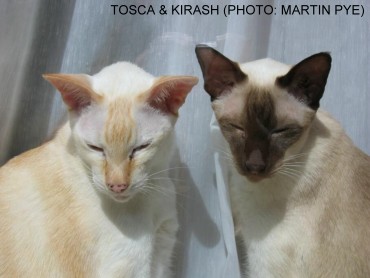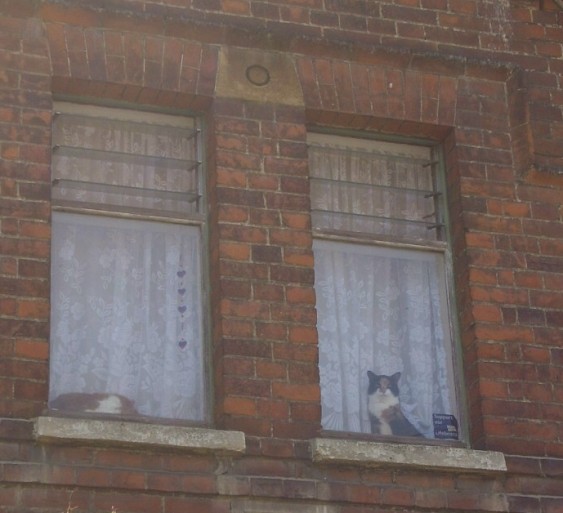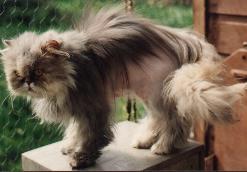 Tosca & Kirash looking out of the window. About 10% of British cats, mostly pedigree cats, are indoors-only. Photo: Martin Pye.
Tosca & Kirash looking out of the window. About 10% of British cats, mostly pedigree cats, are indoors-only. Photo: Martin Pye.
 Two cats indoors on a town street - most likely of their own volition!
Two cats indoors on a town street - most likely of their own volition!
CAT KEEPING IN BRITAIN AND AMERICA
This was originally written in 1994 as a two part article. The two parts have been merged and a few minor updates have been made. Information was accurate at the time of writing and has been kept largely intact and unchanged as a 'snapshot' of 1994. It is intended as a comparison of cat-keeping habits and not to promote nor condemn either method.
POPULATION FIGURES & PROBLEMS
Britain has an estimated 7 million pet cats, less than 10% being pedigrees. The United States has around 60 million pet cats, 40% being pedigrees. Around a quarter of British households own cats compared to nearly a third of American households. Many American cat lovers prefer to call themselves 'caregivers' rather than owners.
The Persian and the Siamese are the most popular breeds both sides of the Atlantic, but after that, national pride takes over with the British Shorthair coming third over here and the Maine Coon looking set to oust the Abyssinian from third place in the US.
For many elderly or disabled persons a cat is their family. In the US, many landlords are now required by law to allow people moving into sheltered accommodation to keep a single indoor cat as long as they are capable of looking after it. This is a very positive move for people moving into sheltered housing.
Despite a high rate of neutering, the US has cat overpopulation problems. Although there are 'no-kill shelters' for cats, 80% of cats presented to shelters never find new homes. Cats over 5 years old are hard to rehome and cats over 10 years old stand little chance of being adopted. Pure economics means that many of these are euthanized. Many animal pounds are legally obliged to sell this surplus of unhomed animals to research laboratories.
The overpopulation problem includes 26 million feral cats. Attempts at wholesale eradication failed and several American groups have been set up along the lines of Cat Action Trust to control the feral population through neutering. The first such group, Alley Cat Allies, is now a national organization providing information to humane societies and individuals involved in TTVAR (Trap-Test-Vaccinate-Alter-Return) Projects.
INDOORS OR OUT?
90% of British cats have free access to outdoors; the indoor 10% are mostly pedigree cats (risk of theft) and cats with injuries or illnesses such as FeLV/FIV. According to surveys, about a quarter of American cats are able to go outdoors. The main reasons for confining a cat indoors is fear of diseases such as rabies, dangerous wildlife, road accidents and cat theft.
This indoor lifestyle is reflected in other statistics. In Britain unneutered toms are more acceptable as pets than they are in the US. An uncastrated tom makes for a pungent indoor-only pet! Conversely, unspayed females are more common as pets in the States than in Britain; since indoor-only females don't risk unplanned pregnancies.
 Tosca & Kirash looking out of the window. About 10% of British cats, mostly pedigree cats, are indoors-only. Photo: Martin Pye. Tosca & Kirash looking out of the window. About 10% of British cats, mostly pedigree cats, are indoors-only. Photo: Martin Pye.
|
 Two cats indoors on a town street - most likely of their own volition! Two cats indoors on a town street - most likely of their own volition!
|
As a consequence of the indoor lifestyle, litter trays and litter box fillers are big business. 70% of American cat owners buy commercial litter compared to less than 30% of British cat owners. Litters range from 'scoopable' and 'multicat formula' to 'reusable' and litter advertising is far more prominent in American magazines than in British ones. Alongside the litter adverts are ads for preparations to reduce litter stool odour. In addition, dried cat foods claim to reduce stool volume - convenient for the owner, but often constipating for the cat as the contents of "Dear Vet" pages in cat magzines demonstrates.
American cat owners can choose between functional plastic litter trays, disposable biodegradable litter trays, 'flushing' Kitty Privvies, two-storey kitty privvies which prevent litter from being tracked all over the house or even buy books on how to train Kitty to use the toilet and eliminate the need for a litter tray altogether.
THE DECLAWING DEBATE
The subject of declawing is the cause of much disagreement between cat lovers. This operation is more-or-less routine for pet cats in many parts of the States (neuter-and-declaw is often offered as a bundle by US vets) and is often the first course of action for a destructive cat. Many other cats end up at humane shelters for the crime of clawing the furniture. Since so few cats get new homes, Kitty may well be better off with a home but no claws than with claws but no home.
A survey in the magazine CAT FANCY found that 31% of respondents had their pet cats declawed, some because the cats refused to use scratching posts while others seemed unwilling to try training their cats. One respondent summed up her reasons for declawing her cat:
"Declaw the cat so you don't have to set any boundaries. A cat already hears enough noes in its life."
69% of respondents were against declawing on humane grounds, because it reduced the cats ability to defend itself or because cats can be trained not destroy household furnishings. Many stated that their cats' wellbeing was more important than the furnishings so the picture is perhaps not as black as it is painted.
There are alternatives to declawing, one is to sever the ligaments which allow the claws to be extended for scratching; the other is to glue caps (e.g. Soft Paws) over the claws so that attempts to scratch don't actually cause any damage. In the past, these caps must be replaced by a veterinarian every time the claws get long enough to need clipping, but many owners now replace the caps themselves. The caps are available in pink and blue, perhaps helping owners whose cats are otherwise identical in colour! In 2006, they were also advertised in the UK.
In Britain, very few cats are declawed except on medical grounds. Some pet cats belonging to families on American airbases in the UK are declawed, making them difficult to rehome if the need arises as relatively few British owners are geared to keeping an indoor-only cat. The British prohibition on declawing is not an indication that animal rights activists are trying to decrease pet ownership, nor are British cats mostly barn cats as is sometimes argued by USAnian cat owners defensive about declawing their pets. Depriving a cat of its primary means of defence is simply considered cruel by the great majority of British cat owners. Whether indoor-only or indoor-outdoor, British pet cats keep their claws. In return, British cat owners find it hard to comprehend how a "cosmetic" mutilation for the sake of the furniture can be considered humane in the USA.
Wild species such as Margays and Ocelots are sometimes kept as pets in the USA and may be defanged as well as declawed. In the UK there are strict regulations covering the care and housing of wild cats; claws and fangs may only be removed due to genuine medical reasons.
BEAUTIFUL CATS
American Cat Magazines frequently carry advertisements for 'hats, jackets and accessories for the fashionable feline' and 'feline finery'. You can get bomber jackets for cats, baseball caps and even fancy Victorian lace collars. Of course, an indoor cat won't be able to drag its finery through the nearest hedge. Apart from the occasional indignity of being dressed up in doll's clothes by children, British cats don't currently have any fashions designed specifically for their feline forms.
Some indoor cats in America get a monthly bath despite never having the chance to get dirty. A regular bath in distilled water apparently removes some of the allergens from a cat's coat. This is beneficial to owners who suffer from asthma, but don't want to give up their cat. Apart from show cats who need to look their best, few British cat-owners bathe their cats. The only time I have ever bathed one of my cats is when she rolled in cold bonfire ashes.

In summertime, longhaired cats in the hottest regions may be clipped. A nearly nude cat with fluffy bootees and fluffy head may look hilarious but at least it won't overheat. In Britain, a cat is rarely clipped except for surgery or, in the case of cats rescued from neglect (left), to remove mats.
THE QUEST FOR NOVELTY
Some British cat fanciers believe that the quest for novelty may have gone too far in the States with the Munchkin and the Sphynx and with attempts to breed genetically miniature cats. Persians come in several varieties depending on whether you like a cat with a punched-in look or one with working tearducts. Siamese cats also come in two varieties as the 'traditional' chunkier Siamese of yesteryear is making a comeback.
Many British cat lovers are not aware that there are two types of Ragdoll cat with a minor spat going on in the classified ads section of cat magazines and litigation over which of the two Ragdoll 'breeds' is the genuine one despite the fact that they all stem from the same foundation cats. It doesn't help that neither party will admit to the existence of the other party. It's a case of 'will the real Ragdoll please step forward?'
In the red corner we have the large, laid-back, but not excessively floppy 'genuine Ragdoll', developed by breakaway breeders and now seen in the UK ("perfectly normal and not in the least limp", Pat Turner, Show World Jan 1993). In the blue corner we have the IRCA variety developed by Ann Baker who claims that her non-aggressive, genetically engineered, floppy-when-held (and even when thrown) cats are the true Ragdolls, the others being an entirely different breed of overbred or half-bred lookalikes sold to an unsuspecting public. In 1992, the following is quoted from a quarter-page advertisement which appeared among breeder ads in a cat magazine:
"Ann Baker, the originator of that genial, huggable breed of house cat called 'Ragdoll Cats' says fraudulent versions of her special feline are on the market. A problem arose when an early franchise purchaser tried to take over the breed. Now there are two entirely different cats on the market with the same name, she says. Only those that qualify for registration through IRCA are authentic Ragdolls."
Also from IRCA are the 'Honey Bear' and 'Miracle' and 'a new breed coming up'. The Honey Bear (claimed to be 'the world's sweetest cat') has a 'childlike personality', while the emerald-eyed Miracle is a 'highly upgraded' Ragdoll in a variety of colours and a choice of long or short hair. IRCA breeds became 'legal breeds the day they were trademarked' thus avoiding the inconvenience of Provisional status. Remember, 'IRCA registers only Cherubims, means Angels non-fighting cats'.
In the US, they existed in parallel and didn't mix; IRCA Ragdolls weren't registered with other associations while 'phoney Ragdolls' weren't registrable with IRCA, but were registrable just about everywhere else - "registrable Ragdolls" gloated the ads. Since this article was originally written, Ann Baker has taken her idiosyncratic view of genetics to the great cattery in the sky. Her feline legacy lives on. IRCA Ragdolls went 'legit' with cat registries as "RagaMuffins". They have the essential Ragdoll characteristics in a wider range of colours and patterns. IRCA Honey Bears are advertised only occasionally.
The quest for the wild-looking cat (or 'Living Room Leopard') has not ended with the California Spangle, Egyptian Mau, Ocicat or Bengal. The American Lynx is a Bobcat hybrid with a wild appearance and tame temperament. Another Bobcat hybrid, the American Bobtail is frequently found in colourpointed varieties as Bobcat males apparently prefer Siamese queens, although some authorities suggest that the Bobtail originated from a mating between a Himalayan and a short-tailed moggy. Some authorities suggest that it is a Manx-like mutation (tail mutations are surprisingly common in cats) and during 1993, breeder advertisements changed from 'Bobcat-hybrids' to 'Bobcat-lookalikes'.
Despite a high-profile launch, the California Spangled remains uncommon. The Bengal is one of a handful of cats developed using a wild cat species from which the desired pattern was 'imported'. Other hybrids include the Savannah, Chausie, Eurochaus and possibly the PixieBob, a bobtailed, polydactylous cat with possible Bobcat ancestry. The Bombay resembles a miniature black panther, but is a Burmese in a black coat.
BREEDER ADVERTISEMENTS
I'm fascinated by American Breed Adverts. Nowhere are mutations established as breeds faster and with greater enthusiasm than in the US. Curled ears? You got it! Stumpy legs? You got it! Hybridized to resemble a wild species? You got it! Cats are no longer 'bred', they are 'genetically engineered'. Devon Rexes and Sphynxes are 'guaranteed hypoallergenic' and several breeds are 'guaranteed against genetic or physical defect' although the guarantee is for one year only, after which the cat is free to mutate if it so desires. The breeder offering 'lifetime guarantees' obviously has more confidence in her cats' genetic stability!
Like Coca-Cola™, many American cat breeds come in two flavours - original and 'new improved'. American Persians come in two varieties, three if you count the increasingly uncommon Peke-Faced. 'Doll-faced' Persians have noses while extreme-type 'Piggy' Persians have high nose-breaks and their nostrils between their eyes. According to a columnist in the American 'CATS MAGAZINE', the Peke-Faced ('an interesting study in anatomy') has nearly died out; the squashed and wrinkled muzzle leading to high mortality rates in the kittens.
The Burmese comes in 'traditional', 'contemporary' and 'European' styles; the contemporary Burmese having a more rounded head, shorter muzzle, large, soulful eyes and a tendency to suffer from third-eyelid problems. The Siamese also comes in two styles, with the chunkier 'Appleheaded' or 'Traditional' Siamese making a comeback beside its tubular 'Classic' counterpart. For a while it looked as though the 'Wild Abyssinian' would mark another return to the 'old-style', having the barred markings which breeders have diligently eliminated from the smaller modern Abyssinian.
A modern cat with delusions of great age is the bald, wrinkly Sphynx ('all purr and no fur', 'no grooming expenses, no fleas and no hairy furniture'): 'from the scrolls of antiquity, the world's most hairless cat' runs the ad, despite the breed's relatively recent origins. The hairless cat from the scrolls of antiquity, the Mexican Hairless, is in no position to contest the claim, having become extinct some time ago.
Since American cats live permanently indoors, there is a quest for a space-saving cat for space-age man. The Mei Toi has been advertised as the 'first genetically miniature cat, mature at 4-5 lb'. I've seen references to 'Little Americans' and 'Mini-Himalayans', but no further details so perhaps the domestic cat is too sensible to allow itself to be miniaturised for our convenience. So far, the closest breeders have gotten is the Munchkin whose 'low center of gravity gives it superb cornering abilities'.
The plush, curly-coated Selkirk Rex is 'the Cat in Sheep's clothing' while the Cornish Rex is as 'soft as sand-washed silk'. Longhaired Rexes have appeared, but didn't catch on - busy people want easy-care cats, so the 'York Chocolate' (also available in Lavender) boasted a 'silky, easy-care' coat. Cats, as well as owners, need wash-and-wear hair hence the lines of IRCA cats which 'resemble Persians' but with 'plush non-matting fur'.
The 'North American Tiffany (Non-Burmese)' is a 'chocoholic's delight' - do you cuddle it or lick it? The 'earesistable' or 'devilish' American Curl looks permanently windswept with ears that curve gently backwards. The Scottish Fold is 'as colorful as the kilts of Scotland', though I haven't yet seen one in Hunting Stuart or Black Watch pattern.
You just can't judge a breed by its name. The longhaired Scottish Fold is called Highland Fold in America, but Coupari in Britain on the grounds that it didn't come from the Highlands. But then, the Balinese didn't come from Bali and the Nebelung doesn't come from Germany despite its German name, nor was it originally developed in Russia despite its claim to 'recreate the turn-of-the-century Russian Blue longhair (though Nebelungs later turned up in Russian-bred litters of Russian Blues). I rather doubt that the Chinese Harlequin originated in China where cats tend to appear on the menu rather than on the showbench. The Singapura may or may not have come from Singapore. Its fortunes took a dive when it was reported that its 'discoverer' took some Abyssinian-type cats out to Singapore with her; however, recent imports and the slogan 'The Love Cat of Singapore' could revive interest. In any case, its authenticity got a boost when Singapore adopted it as a tourist mascot. Naturally, the Siberian is 'from Russia with love'.
Compared to the colourful descriptions in the American advertisements, British ads seem positively restrained ... and perhaps a little boring?
FOOTNOTE
A friend summed up the greatest difference: "In Britain, you can walk along the street and see several cats; in America I saw only one outdoor cat in the whole of two weeks. Where are they all? - Indoors of course, scratching the furniture in frustration!"